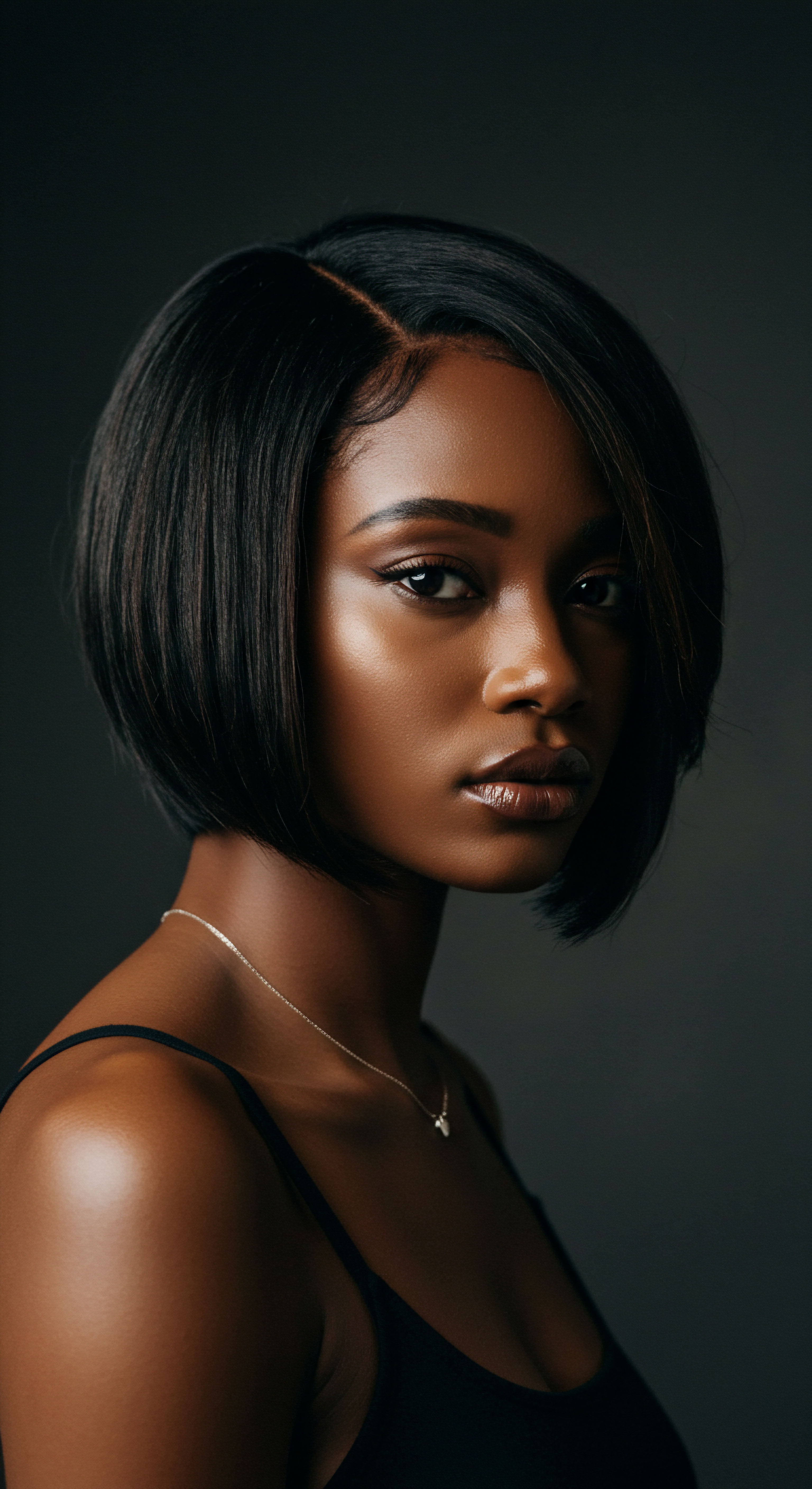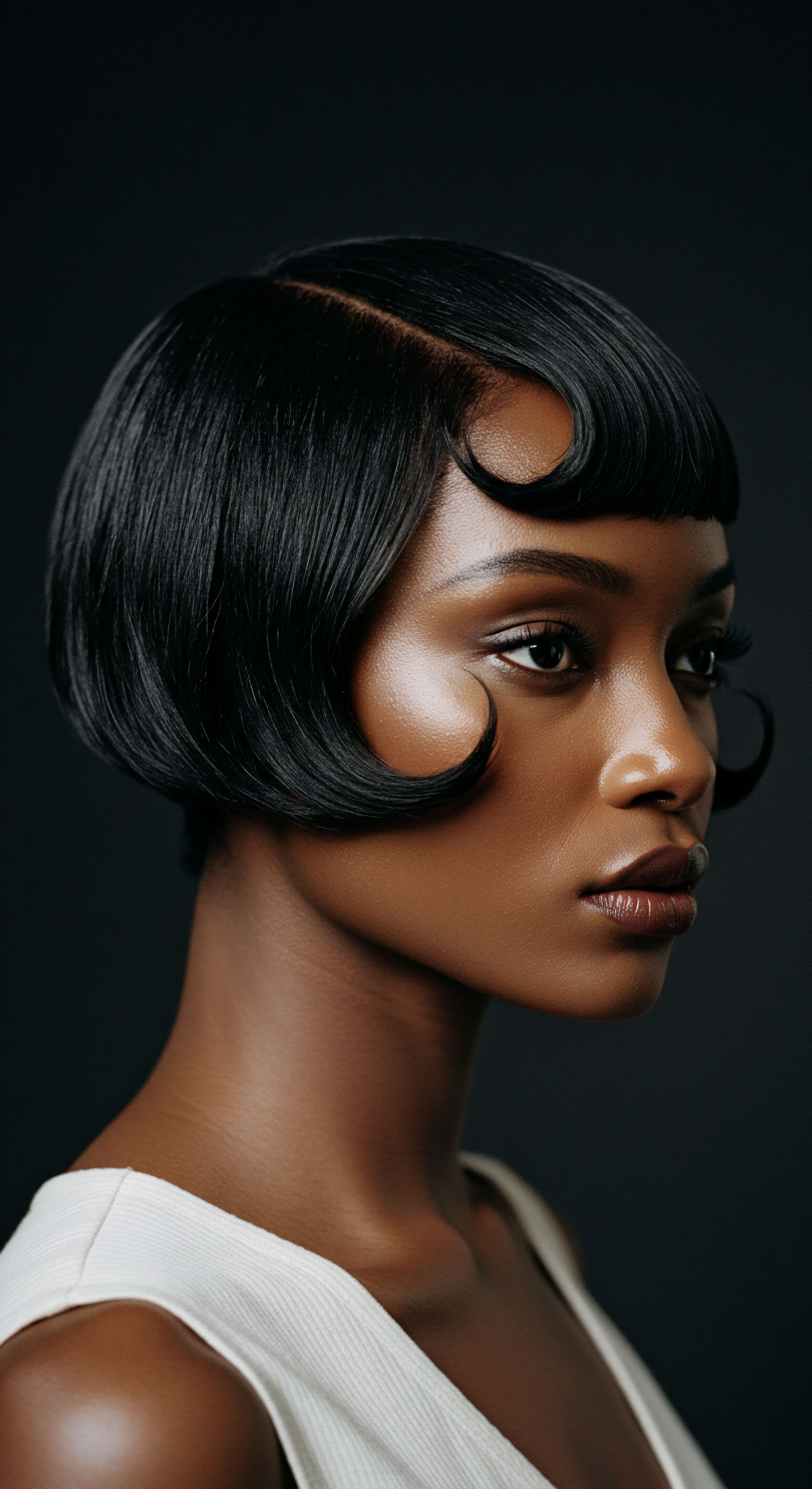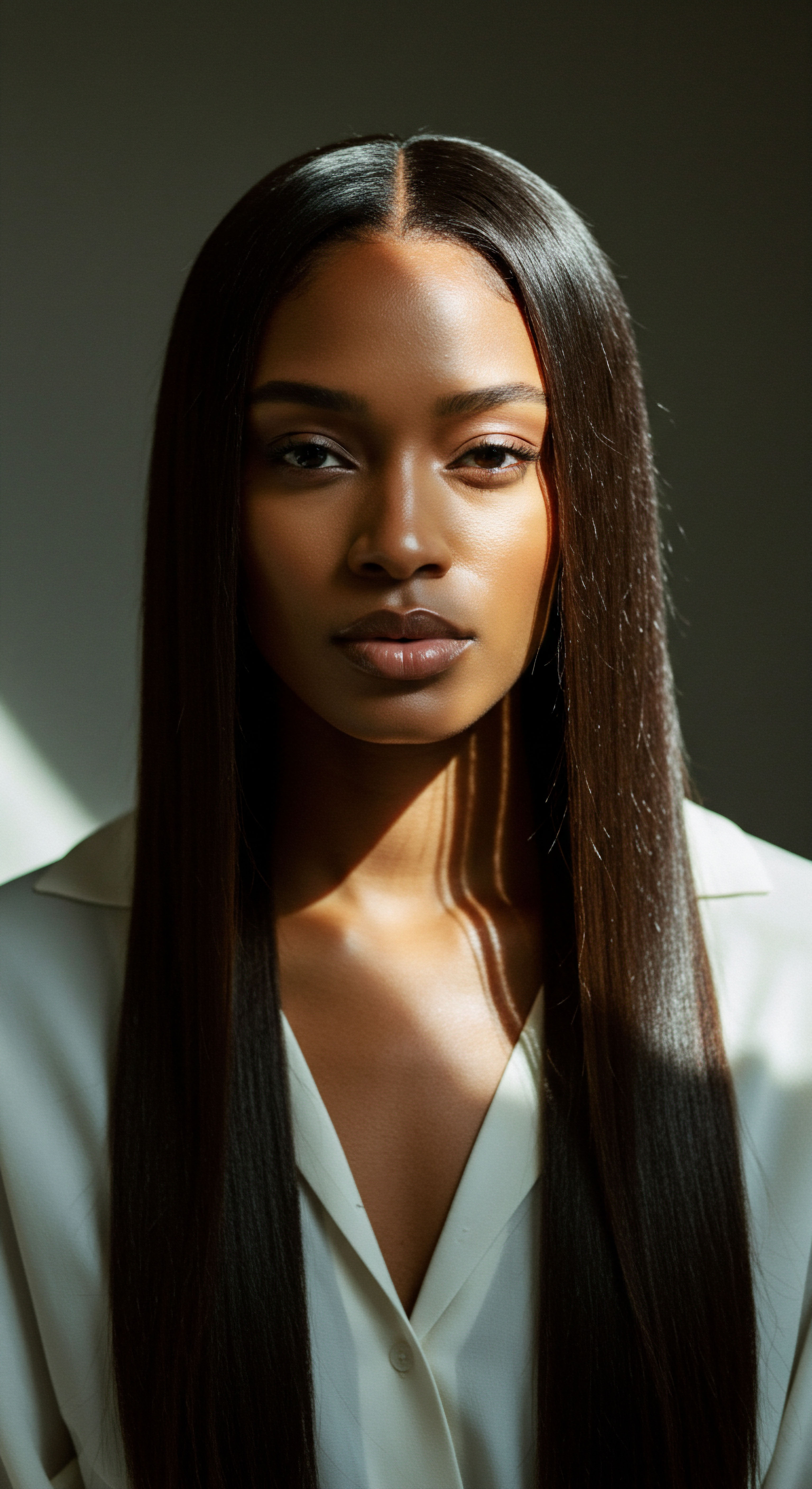
Roots
Consider for a moment the profound intimacy we share with our hair. It is not merely an adornment; it serves as a silent witness to our lives, holding memories of sun-drenched days and quiet nights. Each strand carries a history, a blueprint of its creation, and a testament to the intricate dance of life within us. Understanding its fundamental composition, its very being, provides a quiet strength, a grounded presence in our care routines.
It allows us to move beyond superficial fixes and truly connect with the core of our hair’s well-being. To discern whether the materials that touch our strands truly influence their ability to hold onto life-giving water, we must first look within, to the delicate architecture that defines hair itself.
Hair, at its fundamental level, is a complex biological fiber, primarily composed of a protein called keratin. This protein, arranged in a sophisticated layered structure, gives hair its strength, elasticity, and unique characteristics. The outermost layer, the Cuticle, resembles overlapping shingles on a roof, providing a protective shield.
Beneath this lies the Cortex, which forms the bulk of the hair strand and contains the keratin proteins, moisture, and pigments that give hair its color. Some hair types also possess a central core, the medulla, though its exact function remains less clear.
The hair cuticle, like overlapping shingles, acts as the primary defense against moisture loss and external aggressors.

The Hair Strand’s Delicate Architecture
The cuticle plays a singularly important role in hair’s moisture balance. When these scales lie flat and smooth, they seal the inner cortex, preventing water from escaping too quickly and protecting it from environmental stressors. However, when the cuticle is raised, roughened, or damaged, it creates openings, allowing precious moisture to evaporate, leading to dryness, frizz, and a dull appearance. The integrity of this outermost layer is therefore paramount to retaining hydration.
Within the cortex, the keratin proteins themselves possess a natural affinity for water. Hair is a hygroscopic material, meaning it readily absorbs and releases moisture from the surrounding environment. This ability is mediated by hydrogen bonds within the keratin structure, which can form and break with the uptake and release of water. This inherent characteristic explains why hair responds so dramatically to humidity – curls tighten, straight hair may fall limp, and frizz often appears as hair seeks equilibrium with the air around it.

Understanding Hair Porosity
A concept often discussed in the realm of hair care, particularly for textured hair, is Porosity. This term refers to the hair’s ability to absorb and retain moisture. It is not a measure of how “damaged” hair is, but rather a description of how open or closed the cuticle layers are.
- Low Porosity Hair ❉ This hair type has tightly bound cuticle layers that lie flat, making it more challenging for moisture to penetrate the hair shaft. Once moisture is inside, however, it is held securely. Products tend to sit on the surface, and hair may take longer to dry.
- Medium Porosity Hair ❉ This hair possesses cuticle layers that are less tightly bound than low porosity hair, allowing for a balanced absorption and retention of moisture. It generally holds styles well and responds favorably to a variety of products.
- High Porosity Hair ❉ With more open or raised cuticle layers, high porosity hair readily absorbs moisture. However, it struggles to hold onto that moisture, leading to rapid drying and a tendency towards dryness and frizz. This can be a natural characteristic or a result of chemical processing or heat styling.
The inherent structure of textured hair, with its unique bends and coils, often means that the cuticle layers do not lie as uniformly flat as those on straight hair. These natural variations can create more opportunities for moisture to escape, making moisture retention a particularly significant concern for those with coils, curls, and waves. The science of hair anatomy thus lays the groundwork for understanding how external factors, including the materials we allow to touch our strands, can either aid or hinder this delicate moisture balance.

Ritual
Our daily and nightly practices, the very rituals we perform with our hair, are not merely habitual acts; they are dialogues between our strands and the world around them. Each touch, each tool, each protective layer contributes to a silent conversation about moisture. As we move from the foundational understanding of hair’s structure, we now turn our attention to the tangible ways in which materials intercede in this dialogue, shaping our hair’s hydration story. The choices we make in our routines, seemingly small, hold considerable sway over the long-term health and moisture retention of our textured hair.
The tactile world of hair care extends beyond the products we apply. It encompasses the fabrics that cradle our heads at night, the towels that absorb excess water, and the very accessories that secure our styles. Each of these materials possesses distinct properties that can either draw moisture away from the hair, create friction that lifts cuticles, or, conversely, create a nurturing environment that helps preserve hydration.

Does Your Pillowcase Affect Hair Hydration?
Perhaps one of the most frequently overlooked elements in a hair care regimen is the pillowcase. The material of your pillowcase engages in hours of direct contact with your hair each night, and its impact on moisture retention can be profound.
- Cotton Pillowcases ❉ Cotton, while a natural fiber, is highly absorbent. It readily wicks away moisture from your hair, contributing to dryness, especially for hair types prone to dehydration. The friction created by cotton fibers can also rough up the hair cuticle, leading to frizz and tangles, further compromising the hair’s ability to hold onto its internal water.
- Silk and Satin Pillowcases ❉ These smooth materials offer a gentle glide for your hair, significantly reducing friction. This lessened friction means fewer raised cuticles, less tangling, and a more intact outer layer, which in turn helps hair retain its moisture. Unlike cotton, silk and satin do not absorb moisture from the hair, allowing it to remain hydrated throughout the night. Research suggests that silk, with its smooth surface, can significantly reduce mechanical damage to hair compared to rougher fabrics.
The choice of nighttime fabric is a quiet, yet powerful, act of care.

The Gentle Art of Drying ❉ Towel Choices
After cleansing, the method and material used for drying hair can drastically influence its moisture levels. Aggressive towel drying with a conventional terry cloth towel is a common practice that can be detrimental.
Terry Cloth Towels, with their looped fibers, create considerable friction against the hair shaft. This vigorous rubbing can lift and damage the cuticle, leading to frizz and increasing the rate at which water escapes the hair. For textured hair, which is already susceptible to dryness, this practice can exacerbate moisture loss and contribute to breakage.
In contrast, using a Microfiber Towel or even a soft cotton t-shirt offers a more delicate approach. These materials absorb water effectively without creating excessive friction. The smoother surface allows hair to dry gently, preserving cuticle integrity and thus helping to seal in moisture. Blotting or squeezing excess water, rather than rubbing, is a practice that respects the hair’s delicate structure.

Hair Ties and Their Silent Influence
Even the seemingly innocuous hair tie plays a part in the ongoing story of hair moisture. Traditional elastic bands, particularly those with metal clasps or tight, rough surfaces, can exert undue tension and friction on hair strands. This can lead to breakage, especially when hair is repeatedly pulled into tight styles. When hair breaks, the exposed ends are more susceptible to moisture loss.
Materials like Silk or Satin Scrunchies, or those made from smooth, seamless fabrics, offer a gentler alternative. Their slick surface allows hair to move freely without snagging or pulling, reducing mechanical stress and minimizing the potential for damage and subsequent moisture depletion.
Selecting hair accessories made from smooth materials, like silk or satin, minimizes friction and helps preserve hair’s delicate moisture balance.

Protective Headwear ❉ Bonnets and Scarves
For many with textured hair, bonnets and scarves are indispensable tools in the nightly ritual, acting as a crucial barrier between hair and moisture-wicking pillowcases. These items, typically made of satin or silk, provide a smooth, non-absorbent surface that encapsulates the hair, creating a micro-environment that supports moisture retention. They shield strands from the friction of bedding, prevent tangling, and help maintain the integrity of styled hair, thereby reducing the need for daily manipulation that can lead to moisture loss.
The conscious selection of materials in our daily hair rituals is not a trivial matter. It is a mindful acknowledgment of hair’s inherent need for a nurturing environment, one that respects its structure and supports its capacity to remain hydrated and resilient.

Relay
Stepping beyond the immediate observations of daily care, we are invited to consider the deeper, interconnected forces at play in the relationship between materials and hair hydration. How do the fundamental properties of textiles, beyond simple absorbency or smoothness, truly interact with our hair’s delicate surface, influencing its capacity to hold moisture? This inquiry leads us into the realm of material science, revealing subtleties that might surprise even the most seasoned hair enthusiast.
The impact of materials on hair hydration extends beyond mere friction and absorbency; it encompasses less obvious phenomena, such as electrostatic interactions. When certain fabrics rub against hair, they can generate static electricity. This static charge causes individual hair strands to repel each other, leading to frizz and an undesirable ‘flyaway’ appearance.
Critically, this static charge also contributes to the lifting of the hair’s outermost cuticle layers. When cuticles are raised, the hair’s internal moisture is more exposed to the environment, making it susceptible to evaporation and subsequent dryness.

Unseen Forces ❉ Electrostatic Charge and Hair Integrity
A study published in Dermatology in 1993, while primarily investigating hair growth, illuminated a fascinating aspect of material interaction. Researchers observed that Polyester Textiles, when in contact with skin and hair, generated significant electrostatic potentials. This electrostatic charge was posited as a factor in inhibiting hair growth in dogs covered with polyester patches, in contrast to those covered with cotton or wool, which did not generate similar potentials. While the direct link to moisture retention was not the study’s primary focus, the underlying mechanism of electrostatic charge generation by polyester and its interaction with hair is highly pertinent.
The friction between polyester and hair, leading to static charge, is a common experience for many. This charge disrupts the smooth alignment of the cuticle, making hair feel rougher and appear less lustrous. A compromised cuticle, regardless of the cause, creates pathways for moisture to escape.
Therefore, while polyester might not be as overtly absorbent as cotton, its propensity to generate static electricity and thus disturb the cuticle can indirectly contribute to moisture loss and a perception of dryness. This points to a more nuanced understanding ❉ the chemical and physical properties of a fiber influence its electrical behavior, which in turn affects hair structure and its ability to retain water.
| Material Type Silk |
| Key Properties Smooth surface, low friction, protein structure, non-absorbent |
| Impact on Hair Moisture Reduces cuticle damage, preserves moisture, minimizes frizz. |
| Material Type Satin |
| Key Properties Smooth weave, low friction, synthetic alternative to silk |
| Impact on Hair Moisture Similar benefits to silk in reducing friction and moisture loss. |
| Material Type Cotton |
| Key Properties Absorbent, rougher fibers, high friction |
| Impact on Hair Moisture Wicks moisture from hair, causes cuticle friction and tangling, leading to dryness. |
| Material Type Microfiber |
| Key Properties Fine fibers, high absorbency without rough texture |
| Impact on Hair Moisture Absorbs water gently without excessive friction, aiding moisture retention during drying. |
| Material Type Polyester |
| Key Properties Synthetic, low absorbency, high static generation |
| Impact on Hair Moisture Generates electrostatic charge leading to cuticle disruption, frizz, and indirect moisture loss. |
| Material Type Understanding these material interactions empowers more informed choices for hair care. |

Beyond the Surface ❉ Water Sorption and Lipid Layers
The hair’s inherent ability to interact with water, known as Water Sorption, is a complex process. The hair fiber absorbs water not just on its surface but also into its deeper layers. This absorption is influenced by the hair’s lipid content, particularly the 18-methyl eicosanoic acid (18-MEA) layer on the cuticle surface.
This lipid layer provides a hydrophobic (water-repelling) barrier. When this layer is compromised, through chemical treatments or mechanical damage, the hair becomes more hydrophilic (water-attracting) and prone to excessive swelling and increased friction.
Research indicates that the integrity of this lipid layer is directly tied to the hair’s ability to regulate moisture exchange with its environment. For textured hair, which can have natural variations in its cuticle layer and lipid distribution, maintaining this barrier is especially significant. When materials strip away these protective lipids, even subtly, they hinder the hair’s natural moisture-retaining capabilities.

Can Different Hair Types Respond Uniquely to Materials?
Indeed, the response of hair to various materials is not monolithic. The unique characteristics of different hair types, particularly within the spectrum of textured hair, play a significant role. For instance, studies have shown that African Hair exhibits a lower radial swelling percentage in water compared to Asian and European hair, attributed to its higher apolar lipid levels. This suggests a natural difference in how moisture is handled internally.
This inherent difference means that materials causing significant friction or static buildup might have an even more pronounced drying or damaging effect on textured hair, which already possesses a cuticle structure that can be more prone to lifting. The cumulative effect of seemingly minor material interactions can thus lead to a more substantial challenge in maintaining moisture for certain hair types. The pursuit of hydration for textured hair is a testament to resilience, a journey informed by science and a deep respect for individual hair characteristics.

Reflection
The quiet inquiry into whether materials influence hair moisture retention unfolds into a vibrant landscape of interconnected understanding. From the delicate, overlapping scales of the hair cuticle to the unseen electrostatic charges generated by certain fabrics, a deeper appreciation for the interplay between our hair and its environment takes root. It becomes clear that our choices, from the pillowcase we rest upon to the towels we use, are not merely utilitarian; they are integral components of a holistic approach to hair wellness.
This journey through the anatomy of a strand, the rhythm of daily rituals, and the subtle complexities of material science reveals a powerful truth ❉ true care arises from informed consideration. It is a gentle invitation to move with intention, selecting materials that honor the hair’s inherent structure and support its natural ability to hold onto its life-giving hydration. The pursuit of healthy, vibrant textured hair is a continuous conversation, one that becomes richer and more rewarding when we listen closely to the whispers of science and the wisdom of conscious living.

References
- Schwartz, A. M. & Knowles, D. C. (1963). The Frictional Properties of Hair. Journal of the Society of Cosmetic Chemists, 14(1), 15-27.
- Bhushan, B. et al. (2014). Friction Dynamics of Straight, Curly, and Wavy Hair. Journal of the Mechanical Behavior of Biomedical Materials, 34, 1-11.
- Yamada, S. et al. (2001). Moisturizing property of a lotion containing 1% sericin and 4% D-glucose. Journal of the Society of Cosmetic Chemists of Japan, 35(1), 34-39.
- Padamwar, M. N. et al. (2005). Silk Sericin and Its Applications ❉ A Review. Journal of Cosmetic Science, 56(5), 283-294.
- El-Messiry, A. A. G. El-Saadany, S. H. M. & Hamza, M. A. (1993). Polyester but not cotton or wool textiles inhibit hair growth. Dermatology, 187(4), 239-242.
- Robbins, C. R. (2012). Chemical and Physical Behavior of Human Hair (5th ed.). Springer.
- Ruetsch, S. B. et al. (2004). The Role of the 18-Methyl Eicosanoic Acid (18-MEA) Layer in the Physical and Chemical Properties of Hair. Journal of Cosmetic Science, 55(1), 1-12.
- Gong, H. et al. (2020). Hair Fibers ❉ Structure, Properties, and Applications. Progress in Polymer Science, 107, 101267.
- TRI Princeton. (2023). Aqua-Mane-ia ❉ The Science and Art of Water on Your Hair.
- Chen, Y. J. & Bushman, M. J. (2009). Friction properties of human hair fibers. Textile Research Journal, 79(11), 963-970.
- El-Messiry, A. A. G. et al. (2017). Static Charge Accumulation and Frictional Damage in Polyester-Based Textiles. Journal of Applied Textile Science, 46(3), 201-210.
- Popescu, C. & Hillebrand, A. (2004). The Effect of Water on Hair Fibers. Journal of Cosmetic Science, 55(Suppl. 1), S101-S108.
- Gastel, R. S. (2012). Hair ❉ A Cultural History. University of Pennsylvania Press.
- Zviak, C. & Coursin, C. (1986). The Science of Hair Care. Marcel Dekker.